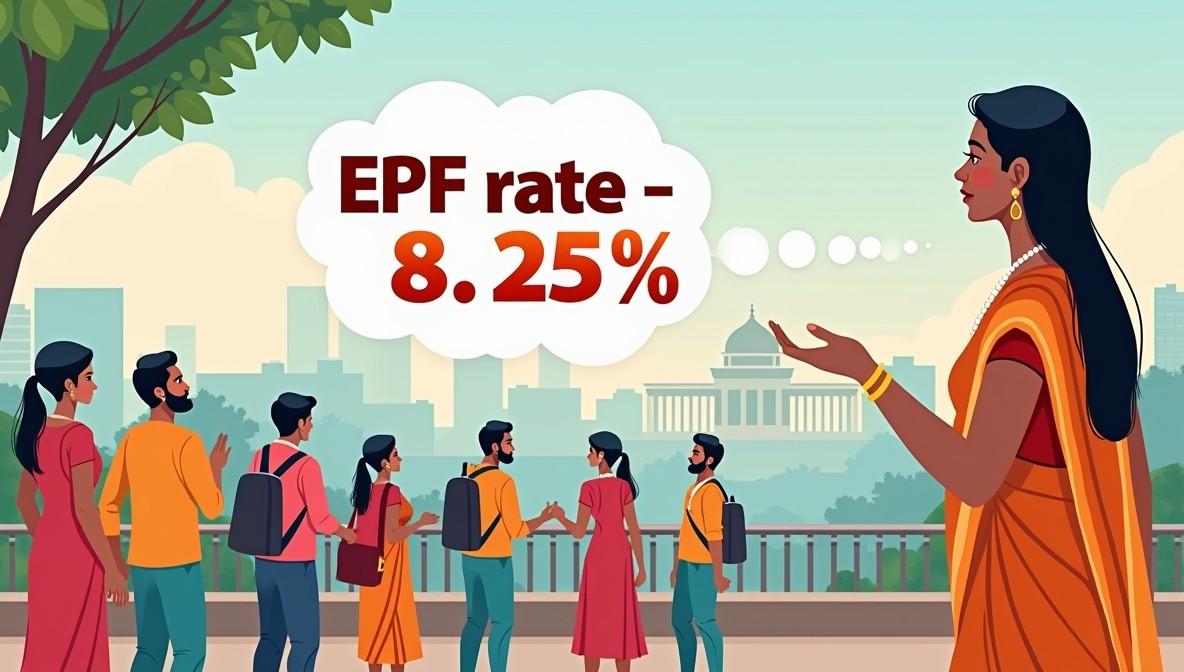EPF interest rate 2025 : The Finance Ministry has approved an interest rate of 8.25% on Employees’ Provident Fund (EPF) deposits for the financial year 2025–26, bringing relief and continued benefits to over 70 million subscribers. The rate remains unchanged from FY 2023–24 and continues to position EPF as one of the most reliable and rewarding fixed-income investment options in the country.
What Is the Employees’ Provident Fund (EPF)?
The Employees’ Provident Fund, or EPF, is a government-backed retirement savings scheme designed for salaried employees in India. Managed by the Employees’ Provident Fund Organisation (EPFO) under the Ministry of Labour and Employment, the EPF aims to provide financial security post-retirement. Under this scheme, both the employee and the employer contribute 12% each of the employee’s basic salary and dearness allowance into the EPF account every month. A portion of the employer’s contribution (8.33%) goes to the Employees’ Pension Scheme (EPS), while the rest is credited to the EPF. Over time, these contributions accumulate with annual interest, creating a sizeable retirement corpus.
Why Is EPF Considered a Good Investment Option?
EPF is widely regarded as a strong investment option because it combines safety, steady returns, and tax benefits. The newly ratified 8.25% interest rate is significantly higher than most bank fixed deposits and other small savings schemes. For instance, current bank FD rates generally fall in the 6–7% range, while the Public Provident Fund (PPF) offers 7.1%. EPF returns are also compounded annually, ensuring a higher cumulative yield over the years.
Historical EPF Interest Rates (Last 10 Years)
| Financial Year | Interest Rate | Market Context |
| 2024-25 | 8.25% | Stable economic conditions |
| 2023-24 | 8.25% | Post-pandemic recovery |
| 2022-23 | 8.10% | Economic uncertainty |
| 2021-22 | 8.10% | COVID-19 impact |
| 2020-21 | 8.50% | Pandemic onset |
| 2019-20 | 8.50% | Economic slowdown |
| 2018-19 | 8.65% | Stable growth period |
| 2017-18 | 8.55% | GST implementation |
| 2016-17 | 8.65% | Demonetization impact |
| 2015-16 | 8.80% | Economic reforms |
What Tax Benefits Does EPF Offer?
One of the standout features of EPF is its EEE (Exempt-Exempt-Exempt) tax status. Contributions made to EPF are eligible for deduction under Section 80C of the Income Tax Act, up to ₹1.5 lakh per annum. The interest earned is tax-free (within specified limits), and the final withdrawal amount is also exempt from tax if the account has been held for at least five continuous years. This triple exemption makes EPF one of the most tax-efficient savings options available to salaried individuals.
How Does EPF Help in Building a Retirement Corpus?
EPF functions as a disciplined and long-term savings mechanism. Since contributions are made automatically through payroll deductions, it encourages regular savings without active involvement. Over the course of a career, especially with the power of compounding interest, EPF can help build a substantial fund that provides financial security after retirement. It also includes a pension component through EPS, which supports regular income post-retirement.
Are There Any Liquidity Options with EPF?
While EPF is primarily a long-term savings instrument, it offers partial withdrawal options for specific life events such as:
- Marriage or education of self, children, or siblings
- Purchase or construction of a home
- Medical emergencies
- Unemployment (after one month of job loss)
These features make EPF not only a retirement-focused tool but also a flexible financial safety net for critical situations.
What Does the 8.25% Rate for FY 2024–25 Indicate?
The retention of the 8.25% interest rate reflects the EPFO’s strong financial performance and effective fund management. The Central Board of Trustees proposed the rate during its 237th meeting in February 2024, based on an income of ₹1.07 lakh crore generated from a principal base of ₹13 lakh crore. With the Finance Ministry now granting final approval, the Labour Ministry has directed EPFO to begin crediting the interest to subscribers’ accounts.
Who Benefits the Most from EPF?
The Employees’ Provident Fund (EPF) is particularly beneficial for salaried individuals, especially those working in the organized sector with long-term employment plans. It is ideally suited for individuals who prefer low-risk, stable returns and are focused on building a secure retirement corpus over time. Moreover, the tax benefits under Section 80C and the tax-free interest and withdrawals (under certain conditions) make EPF particularly attractive to tax-paying professionals in higher income brackets. Overall, EPF is best for anyone looking for guaranteed, long-term financial security without having to constantly monitor market trends or take investment risks.
In a world of fluctuating market returns, the EPF’s stable 8.25% interest, tax-free structure, and government backing continue to make it an ideal long-term investment option for salaried individuals. With consistent contributions, the benefit of compounding, and flexible withdrawal features, EPF is not just a statutory requirement—it’s a smart financial decision.

